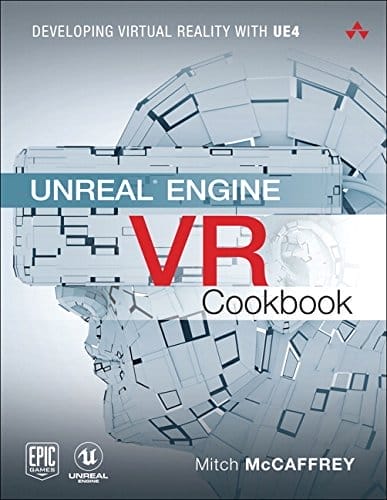In the ever-evolving world of game development, the rise of virtual reality (VR) has opened up a plethora of opportunities for creators. Among the arsenal of resources available, the ‘Unreal Engine VR Cookbook’ stands out like a beacon for both novices and seasoned developers. Imagine being able to build immersive worlds from the ground up, and here, we explore how this cookbook guides you in this thrilling journey. With its unique recipes and step-by-step instructions, it’s more than just a guide; it’s a passport to your VR ambitions. Whether you are a hobbyist or a professional, this blog sheds light on how to navigate the VR landscape effectively.

Introduction to the Unreal Engine VR Cookbook
The Unreal Engine VR Cookbook is more than just a book; it’s a gateway into the exciting world of virtual reality (VR) development. Authored by Mitch McCaffrey, this book aims to equip developers with the tools and knowledge needed to create immersive VR experiences. But why is VR development so crucial today? And what makes Unreal Engine a standout choice in the gaming industry? Let’s dive into these questions.
Overview of the Book’s Purpose
The primary goal of the Unreal Engine VR Cookbook is to serve as a comprehensive guide for both beginners and seasoned developers. It provides practical tips and user-friendly recipes that simplify the complex world of VR. Each chapter is designed to teach essential elements of VR development, from basic concepts to advanced techniques. The book is structured to allow readers to learn at their own pace, making it an excellent resource for anyone looking to break into VR.
Why VR Development Matters Now
In today’s digital landscape, VR is not just a novelty; it’s a transformative technology. With applications ranging from gaming to education and healthcare, VR is reshaping how we interact with digital content. The demand for VR experiences is skyrocketing. Developers who can harness this technology will find themselves at the forefront of innovation. As Luis Cataldi from Epic Games states,
“For game developers and visualization specialists, VR is the next amazing frontier to conquer.”
This sentiment captures the urgency and excitement surrounding VR development.
The Significance of Unreal Engine in the Gaming Industry
Unreal Engine has established itself as a powerhouse in the gaming industry. Its robust features and flexibility make it the go-to platform for many developers. The engine supports high-quality graphics and realistic physics, which are essential for creating immersive VR experiences. Moreover, Unreal Engine is continuously updated, ensuring that developers have access to the latest tools and technologies. This adaptability is crucial in a fast-evolving field like VR.
With the Unreal Engine VR Cookbook, developers can learn how to leverage the engine’s capabilities effectively. The book covers various aspects, such as:
- Implementing VR logic with Blueprint visual scripting
- Creating projects compatible with Oculus Rift, HTC Vive, and more
- Managing seated and standing VR experiences
- Optimizing VR applications for better performance
Who the Author Is and His Background
Mitch McCaffrey is not just an author; he is a renowned VR developer and instructor. His expertise in Unreal Engine and VR development is well-established. He runs a popular YouTube channel, Mitch’s VR Lab, where he shares insights and tutorials that help thousands of aspiring developers. McCaffrey’s hands-on experience and teaching background make him uniquely qualified to guide readers through the complexities of VR development.
His approach in the Unreal Engine VR Cookbook is practical and accessible. He provides step-by-step instructions that empower readers to create their own VR projects. This cookbook-style format allows for easy reference, making it a valuable tool for developers at any level.
In summary, the Unreal Engine VR Cookbook is a vital resource for anyone interested in VR development. It not only covers the technical aspects but also emphasizes the importance of understanding the underlying principles. With McCaffrey’s guidance, readers can navigate the exciting world of VR and create stunning experiences that push the boundaries of what’s possible.
Navigating the Book’s Unique Structure
The Unreal Engine VR Cookbook by Mitch McCaffrey is not just another cookbook; it’s a well-structured guide that leads readers through the fascinating world of Virtual Reality (VR) development. Understanding its unique structure can significantly enhance your learning experience. Here’s how it’s laid out and what to expect.
The Format and Layout of the Cookbook
The book is designed with clarity in mind. Each chapter is laid out in a way that makes it easy to follow. The format is user-friendly, combining text with visuals to aid understanding. You’ll find:
- Step-by-step instructions: Each recipe is presented with clear steps, ensuring that even beginners can follow along.
- Visual aids: Diagrams and screenshots are included to illustrate key concepts and processes.
- Practical examples: Real-world applications of the concepts are provided, making it easier to grasp complex ideas.
How Recipes Are Organized and Structured
One of the standout features of this cookbook is how the recipes are organized. They are grouped into logical sections, allowing readers to jump to what they need. This is particularly useful for those who may already have some knowledge of Unreal Engine but want to focus on specific areas. The organization includes:
- Clear headings: Each recipe starts with a title that indicates what you’ll learn.
- Learning outcomes: At the beginning of each chapter, the expected outcomes are clearly defined. This helps readers understand what they will achieve.
- Practical applications: Recipes focus on applying concepts rather than just theory. This hands-on approach is ideal for learning.
Key Chapters and Their Focus Areas
The book is divided into several key chapters, each focusing on different aspects of VR development. Here are some of the highlights:
- Introduction to VR: This chapter covers the basics of VR, including terminology and fundamental concepts.
- Blueprint Visual Scripting: Readers learn to implement VR logic using Unreal Engine’s Blueprint system, making it accessible even for those with minimal programming experience.
- Creating Interactive Objects: This section dives into how to create and manage interactive elements within a VR environment.
- Optimization Techniques: Here, readers discover how to enhance the performance of their VR applications, ensuring a smooth user experience.
Specific Tools and Techniques Covered
The book doesn’t just stop at theory; it provides practical tools and techniques that are essential for VR development. Some of the specific tools and techniques covered include:
- Unreal Motion Graphics (UMG): This tool is essential for creating user interfaces in VR.
- Character Inverse Kinematics (IK): Readers learn how to implement IK for realistic movement of characters in VR.
- Trace Interactions: This technique is crucial for creating engaging user experiences.
- Motion Controller Interaction: Understanding how to effectively use motion controllers is a key part of VR development.
“Mitch has helped thousands of people understand the foundations of locomotion and interaction mechanics with clear and concise UE4 videos.” — User review
This quote encapsulates the essence of the book. It’s not just about following recipes; it’s about understanding the underlying principles that make VR work. The text offers immediate results and a deep understanding of complex concepts, making it a valuable resource for both beginners and experienced developers.
In conclusion, navigating the unique structure of the Unreal Engine VR Cookbook allows readers to maximize their learning. With its practical focus, clear organization, and comprehensive coverage of essential tools and techniques, this book is a must-have for anyone looking to dive into the world of VR development.
Essential VR Concepts Covered
Virtual Reality (VR) is an exciting and rapidly evolving field. For anyone stepping into this world, understanding the basic concepts is crucial. This section will explore essential VR terminology, the different types of VR experiences, how to manage user experience to prevent motion sickness, and the setup of interactive objects.
1. Understanding Basic VR Terminology
First things first, what is VR? At its core, Virtual Reality immerses users in a computer-generated environment. But there’s more to it. Here are some key terms:
- Immersion: This refers to the feeling of being present in a virtual environment.
- Head-Mounted Display (HMD): This is the device worn on the head to experience VR.
- Tracking: This technology captures the user’s movements, allowing them to interact with the virtual space.
- Interaction Paradigms: These are the methods through which users interact with VR environments, such as gaze, gesture, or controller input.
Understanding these terms lays the foundation for deeper learning. It’s like learning the alphabet before writing a novel. Without these basics, one might feel lost in the vast VR landscape.
2. Differentiating Between Types of VR Experiences
Not all VR experiences are created equal. They can be broadly categorized into three types:
- Non-Immersive VR: This type uses a computer screen to simulate a VR environment. Think of video games played on a monitor.
- Semi-Immersive VR: This experience combines real-world elements with virtual ones. For example, using a projector to display a virtual environment while users interact with physical objects.
- Fully Immersive VR: This is the most engaging type, where users wear HMDs and are completely surrounded by a virtual environment.
Each type has its own applications and benefits. For instance, fully immersive VR is fantastic for gaming and training simulations, while non-immersive VR can be used for casual entertainment or education.
3. How to Manage User Experience and Prevent Motion Sickness
Motion sickness can be a significant barrier in VR. It occurs when there’s a disconnect between what the user sees and what their body feels. Here are some strategies to mitigate this:
- Frame Rate: Ensure a high and steady frame rate to create smooth visuals.
- Field of View: A wider field of view can enhance immersion and reduce discomfort.
- Movement Techniques: Use teleportation instead of continuous movement to help users navigate without feeling sick.
By implementing these strategies, developers can create a more enjoyable experience. After all, who wants to feel nauseous while exploring a virtual world?
4. Setting Up Interactive Objects and Trace Interactions
Interactivity is a key feature of VR. Users should be able to engage with objects in the virtual environment. Here’s how to set it up:
- Interactive Objects: Use Blueprints in Unreal Engine to create objects that users can grab, move, or manipulate.
- Trace Interactions: Implement trace lines to detect when users are pointing at or hovering over objects. This can trigger actions like highlighting or activating the object.
Creating these interactions not only enhances user engagement but also makes the virtual environment feel more alive. Imagine a world where every object responds to your touch!
“The techniques McCaffrey explains help you get immediate results on various platforms.” — User review
This section dives into the fundamental aspects of VR development critical for newcomers and intermediates alike. The book effectively breaks down complex ideas into understandable segments. It emphasizes practical exercises to reinforce learning, ensuring that readers can apply what they learn. Additionally, the appendix chapters guide readers to essential online resources, making it easier to continue their education in VR.
With these concepts in mind, anyone can start their journey into the captivating world of Virtual Reality. Whether they aim to create games, simulations, or educational tools, understanding these basics is the first step toward success.
User Experiences and Feedback
When it comes to learning, nothing beats the insights from those who have walked the path before. The Unreal Engine VR Cookbook has garnered a range of user experiences, painting a vivid picture of its effectiveness and areas for improvement. Let’s dive into what readers are saying.
Positive Reviews Highlighting Effectiveness
Many users have praised the cookbook for its practical utility. For instance, Brady Gudgel, a verified reviewer, rated it 5.0 out of 5 stars, stating,
“I built an entire multiplayer VR framework using this book in Unreal Engine 4.26. It’s a great addition and has MANY helpful codes to copy.”
This sentiment is echoed by others who found the book to be a valuable learning tool.
Another reviewer, Jason, shared his experience, saying,
“The book was really helpful for my VR development. Detailed guide on how to develop for VR using UE4. Definitely recommended.”
Such feedback highlights the cookbook’s effectiveness in teaching essential VR development skills.
Critical Insights on Limitations
However, not all feedback is glowing. Some users have pointed out limitations. For example, James rated the book 4.0 out of 5 stars and noted that while it is great for those with basic UE4 knowledge, it may not make one an expert. He mentioned, “This won’t make you an expert, but by the end of the book most readers will understand and have the capability to create basic VR apps.” This suggests that while the book is helpful, it may not cover advanced topics in depth.
Another reviewer expressed concerns about the book’s content being somewhat outdated due to Unreal Engine’s frequent updates. Carol Ehrenreich rated it 3.0 out of 5 stars and remarked, “This book has great stuff but not cutting edge.” Such insights are crucial for potential readers to consider.
Common Challenges Faced by Readers
Readers have also shared common challenges they faced while using the cookbook. Many have noted that the book assumes a certain level of familiarity with Unreal Engine. James, for instance, advised that beginners should watch YouTube videos to grasp the basics before diving into the book. He stated, “If you don’t know how to perform basic operations in Unreal, it will be difficult to focus on the VR concepts.” This highlights the importance of having prior knowledge to fully benefit from the book.
Invaluable Resources Shared by the Author
One of the standout features of the Unreal Engine VR Cookbook is the invaluable resources provided by the author. Many readers have pointed out the GitHub files shared by Mitch McCaffrey, which serve as a great supplement to the book. Brady Gudgel emphasized the importance of grabbing these files, stating, “Make sure you grab Mitch’s files from GitHub too!” These resources can significantly enhance the learning experience and provide practical examples for readers to work with.
Conclusion
Insights gained from extensive user feedback paint a picture of the book’s real-world applicability and effectiveness for VR development. While it has received high praise for its practical utility and depth of knowledge, constructive criticism has also surfaced, focusing on areas needing updates. Many readers recommend supplementary resources for newbies, ensuring they are well-prepared to tackle the challenges of VR development.
Conclusion: Is the Unreal Engine VR Cookbook Right for You?
As the world of virtual reality (VR) continues to evolve, the Unreal Engine VR Cookbook stands out as a valuable resource for developers. This book, authored by Mitch McCaffrey, offers a comprehensive guide to creating immersive VR experiences using Unreal Engine 4. But is it the right fit for you? Let’s explore the key benefits of the book, who should consider purchasing it, and the future of VR development.
Key Benefits of the Book
The Unreal Engine VR Cookbook provides a wealth of information that can be incredibly beneficial for both novice and experienced developers. Here are some of its standout features:
- Step-by-Step Instructions: Each chapter is structured like a recipe, guiding readers through the process of implementing various VR functionalities.
- Comprehensive Coverage: From basic VR concepts to advanced techniques, the book covers a wide range of topics, including motion controller interaction and optimization strategies.
- Practical Application: The book emphasizes practical knowledge, allowing developers to apply what they learn immediately.
- Community Resources: It also points readers towards additional resources, fostering a sense of community among VR developers.
These benefits make it a solid choice for anyone looking to deepen their understanding of VR development.
Who Should Consider Purchasing It?
This book is particularly suited for:
- Beginner Developers: Those who have a basic understanding of Unreal Engine but are new to VR will find this book helpful.
- Intermediate Developers: Developers with some experience in VR can enhance their skills and learn new techniques.
- Educators: Instructors looking for a structured resource to teach VR concepts can use this book as a foundational text.
However, it’s important to note that the book is not for everyone. If someone is entirely new to Unreal Engine, they might find it beneficial to familiarize themselves with the basics first. As one user review aptly put it, “Most of this stuff is already built into UE4 templates, but it’s essential to understand the mechanics at a granular level…” This highlights the need for foundational knowledge before diving into the cookbook.
Future Trends in VR Development
The landscape of VR development is rapidly changing. With advancements in hardware and software, staying updated is crucial. The Unreal Engine VR Cookbook emphasizes the importance of ongoing learning. As technologies evolve, developers must adapt and expand their skill sets. This book serves as a stepping stone, but it should not be the end of the journey.
Encouragement for New Developers
For those just starting their VR development journey, the cookbook is an excellent resource. However, it’s essential to explore beyond this single source. The VR community is vast, with numerous online forums, tutorials, and resources available. Engaging with these can provide fresh perspectives and insights.
In conclusion, the Unreal Engine VR Cookbook is a valuable tool for anyone serious about VR development. It offers practical knowledge, clear instructions, and a roadmap for creating immersive experiences. While no book is perfect, being aware of its strengths and limitations can help shape expectations. As the VR landscape continues to evolve, developers should remain curious and committed to learning. The journey into VR is just beginning, and the possibilities are endless.
Buy Unreal Engine VR Cookbook
(as of [price_update_date] – Details)
[ad_2]



















